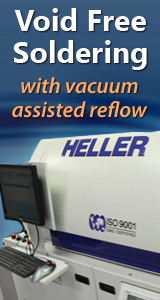CERAMIC CIRCUITRY Starting with hybrid thick film circuits in 1965 at Sperry Flight Systems, I have been involved with ceramics (usually aluminum oxide) as the substrate material. Then, we developed "multilayer" circuitry (replacing "cordwood" modules) in TO-8 packages up to 4 double sided, 20 mil thick circuits with co-fired, 1 mil lines (gold or other specified metals - not silver) with glass insulation and more circuitry printed over that. Resistor ink was applied and cured with chip caps also bonded to the circuitry as the first SMT, etc. Holes were preformed in the alumina in the "green" (uncured) state and metallized when circuitry was screen printed. More often, pins were inserted to achieve continuity from one circuit substrate to another throughout the structure. In those days, rubylith material was used as the primary photo tool and circuits were laid out at 20:1 using cutting and peeling methods with photo reduction providing precise circuit dimensions. Resistors were air abraded to "trim" them into tolerance. This gave way to laser trimming and improved resistor inks capable of holding specified TCR's to within 5% over time and temperature. Things haven't changed too much except for the exceptional work done at Amdahl in the 1970's as we designed and fabricated 22 layer circuits, as MCC's, for use in mainframes. Substrate size was, and still is, 10"x10" with laser "drilled" micro vias. Very expensive, but very effective for large computer applications costing millions. In the late 1970's and early 80's, we designed and produced PCB sized (4"x6") ceramic printed circuitry using many of the same principles as Amdahl and earlier hybrid technologies. Again, cost was considerable but advantages were clear as SMT emerged with matching TCE's for both ceramic substrates and leadless devices bonded to surfaces. We got away from this with the advent of copper Invar copper constraining and tailoring cores (also Kevlar & carbon fiber types) used in polyimide multilayer constructions for TCE matching and higher thermal transfer characteristics. It should be noted in flight applications heat needs to get out and ceramic does not transfer heat (period) whereas metal cores or surface heat sinks do get it to "cold" walls - then to atmosphere. Lately, I have been working (as have many others) with CLTE material (available from Arlon under license from Rogers soon to produce theirs with newly acquired treaters) with ceramic chunks mixed as a "frit" in a Teflon material that is impregnated into 106 glass style fabric (in much the same way as other resin/glass systems) as used in typical MLB's. It provides excellent physical (high dimensional stability in all axes) and electrical characteristics (DC = 2.94, as an example) not found in GETEK or similar materials. With better up front design considerations at the component and PCB levels, many problems have been resolved for R/F applications operating at very high speeds. Cost is still a problem with CLTE, at about 4 times the material cost of epoxy resin systems and specialized processing requirements, as sodium preconditioning for laminate bond strength and hole preparation for plating adhesion, are required. Limited availability (material and fabrication) also is a resolvable problem (stock your own material and provide it to your selected supplier), and when even the best suppliers are used, x-sections provide some interesting insight as quality violations often apparent in accordance with military specifications - as an example (as received {registration as an example}and after thermal stress {delamination and hole wall separation as examples}). The above considerations must be taken into account to achieve yields and cost effectiveness not withstanding availability from qualified suppliers (few exist either for ceramic boards or large substrate material sizes). Also, ceramics are very costly and brittle, and require careful handling and mounting to avoid breakage. Earl Moon - Proof Of Design (pod@ix.netcom.com)
reply »
![]()
![]() CERAMIC CIRCUITRY
Starting with hybrid thick film circuit...
- Feb 25, 1998
by
CERAMIC CIRCUITRY
Starting with hybrid thick film circuit...
- Feb 25, 1998
by






